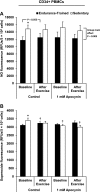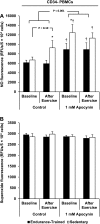Effects of acute and chronic endurance exercise on intracellular nitric oxide and superoxide in circulating CD34⁺ and CD34⁻ cells
- PMID: 21700895
- PMCID: PMC3174794
- DOI: 10.1152/japplphysiol.00541.2011
Effects of acute and chronic endurance exercise on intracellular nitric oxide and superoxide in circulating CD34⁺ and CD34⁻ cells
Abstract
We investigated the influence of acute and chronic endurance exercise on levels of intracellular nitric oxide (NO), superoxide (O₂·⁻), and expression of genes regulating the balance between these free radicals in CD34⁺ and CD34⁻ peripheral blood mononuclear cells (PBMCs; isolated by immunomagnetic cell separation). Blood samples were obtained from age- and body mass index (BMI)-matched endurance-trained (n = 10) and sedentary (n = 10) men before and after 30 min of exercise at 75% maximal oxygen uptake (·VO(₂max)). Baseline levels of intracellular NO (measured by DAF-FM diacetate) and O₂·⁻ (measured by dihydroethidium) were 26% (P < 0.05) and 10% (P < 0.05) higher, respectively, in CD34⁺ PBMCs from the sedentary group compared with the endurance-trained group. CD34⁺ PBMCs from the sedentary group at baseline had twofold greater inducible nitric oxide synthase (iNOS) mRNA and 50% lower endothelial NOS (eNOS) mRNA levels compared with the trained group (P < 0.05). The baseline group difference in O₂·⁻ was eliminated by acute exercise. Experiments with apocynin indicated that the training-related difference in O₂·⁻ levels was explained by increased NADPH oxidase activity in the sedentary state. mRNA levels of additional angiogenic and antioxidant genes were consistent with a more angiogenic profile in CD34⁺ cells of trained subjects. CD34⁻ PBMCs, examined for exploratory purposes, also displayed a more angiogenic mRNA profile in trained subjects, with vascular endothelial growth factor (VEGF) and eNOS being more highly expressed in trained subjects. Overall, our data suggest an association between the sedentary state and increased nitro-oxidative stress in CD34⁺ cells.
Figures




Similar articles
-
Effects of acute and chronic endurance exercise on intracellular nitric oxide in putative endothelial progenitor cells: role of NAPDH oxidase.Am J Physiol Heart Circ Physiol. 2009 Nov;297(5):H1798-805. doi: 10.1152/ajpheart.00347.2009. Epub 2009 Aug 28. Am J Physiol Heart Circ Physiol. 2009. PMID: 19717732 Free PMC article.
-
Short-term exercise training improves flow-mediated dilation and circulating angiogenic cell number in older sedentary adults.Appl Physiol Nutr Metab. 2016 Aug;41(8):832-41. doi: 10.1139/apnm-2015-0637. Epub 2016 Mar 28. Appl Physiol Nutr Metab. 2016. PMID: 27441589 Free PMC article.
-
Oxidative stress and increased eNOS and NADPH oxidase expression in mouse microvessel endothelial cells.J Cell Physiol. 2007 Sep;212(3):682-9. doi: 10.1002/jcp.21063. J Cell Physiol. 2007. PMID: 17443690
-
Nitric oxide and oxidative stress in vascular disease.Pflugers Arch. 2010 May;459(6):923-39. doi: 10.1007/s00424-010-0808-2. Epub 2010 Mar 21. Pflugers Arch. 2010. PMID: 20306272 Review.
-
Exercise and vascular function in sedentary lifestyles in humans.Pflugers Arch. 2023 Jul;475(7):845-856. doi: 10.1007/s00424-023-02828-6. Epub 2023 Jun 5. Pflugers Arch. 2023. PMID: 37272982 Review.
Cited by
-
Liver-Metabolizing Genes and Their Relationship to the Performance of Elite Spanish Male Endurance Athletes; a Prospective Transversal Study.Sports Med Open. 2019 Dec 9;5(1):50. doi: 10.1186/s40798-019-0227-7. Sports Med Open. 2019. PMID: 31820125 Free PMC article.
-
Prior endurance exercise prevents postprandial lipaemia-induced increases in reactive oxygen species in circulating CD31+ cells.J Physiol. 2011 Nov 15;589(Pt 22):5539-53. doi: 10.1113/jphysiol.2011.215277. Epub 2011 Sep 19. J Physiol. 2011. PMID: 21930598 Free PMC article. Clinical Trial.
-
The impact of acute and chronic aerobic and resistance exercise on stem cell mobilization: A review of effects in healthy and diseased individuals across different age groups.Regen Ther. 2024 May 7;27:464-481. doi: 10.1016/j.reth.2024.04.013. eCollection 2024 Dec. Regen Ther. 2024. PMID: 38745840 Free PMC article.
-
Effects of Exercise on Gene Expression of Inflammatory Markers in Human Peripheral Blood Cells: A Systematic Review.Curr Cardiovasc Risk Rep. 2015;9(7):34. doi: 10.1007/s12170-015-0463-4. Curr Cardiovasc Risk Rep. 2015. PMID: 26005511 Free PMC article. Review.
-
Investigating the extremes of the continuum of paracrine functions in CD34-/CD31+ CACs across diverse populations.Am J Physiol Heart Circ Physiol. 2017 Jan 1;312(1):H162-H172. doi: 10.1152/ajpheart.00342.2016. Epub 2016 Oct 28. Am J Physiol Heart Circ Physiol. 2017. PMID: 27793853 Free PMC article.
References
-
- American College of Sports Medicine ACSM Guidelines for Exercise Testing and Prescription. Baltimore, MD: Lippincott, Williams, and Wilkins, 2000
-
- Asahara T, Kawamoto A. Endothelial progenitor cells for postnatal vasculogenesis. Am J Physiol Cell Physiol 287: C572–C579, 2004 - PubMed
-
- Asahara T, Murohara T, Sullivan A, Silver M, van der Zee R, Li T, Witzenbichler B, Schatteman G, Isner JM. Isolation of putative progenitor endothelial cells for angiogenesis. Science 275: 964–966, 1997 - PubMed
-
- Awad O, Dedkov EI, Jiao C, Bloomer S, Tomanek RJ, Schatteman GC. Differential healing activities of CD34+ and CD14+ endothelial cell progenitors. Arterioscler Thromb Vasc Biol 26: 758–764, 2006 - PubMed
-
- Cooke CL, Davidge ST. Peroxynitrite increases iNOS through NF-kappaB and decreases prostacyclin synthase in endothelial cells. Am J Physiol Cell Physiol 282: C395–C402, 2002 - PubMed
Publication types
MeSH terms
Substances
Grants and funding
LinkOut - more resources
Full Text Sources
Medical
Miscellaneous

